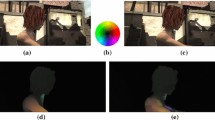Abstract
We address the theoretical problems of optical flow estimation and image registration in a multi-scale framework in any dimension. Much work has been done based on the minimization of a distance between a first image and a second image after applying deformation or motion field. Usually no justification is given about convergence of the algorithm used. We start by showing, in the translation case, that convergence to the global minimum is made easier by applying a low pass filter to the images hence making the energy “convex enough”. In order to keep convergence to the global minimum in the general case, we introduce a local rigidity hypothesis on the unknown deformation. We then deduce a new natural motion constraint equation (MCE) at each scale using the Dirichlet low pass operator. This transforms the problem to solving the energy minimization in a finite dimensional subspace of approximation obtained through Fourier Decomposition. This allows us to derive sufficient conditions for convergence of a new multi-scale and iterative motion estimation/registration scheme towards a global minimum of the usual nonlinear energy instead of a local minimum as did all previous methods. Although some of the sufficient conditions cannot always be fulfilled because of the absence of the necessary a priori knowledge on the motion, we use an implicit approach. We illustrate our method by showing results on synthetic and real examples in dimension 1 (signal matching, Stereo) and 2 (Motion, Registration, Morphing), including large deformation experiments.
Similar content being viewed by others
References
L. Alvarez, J. Esclarin, M. Lefébure, and J. Sanchez, “A PDE model for computing the optical flow,”in Proc. XVI Congresso de Ecuaciones Diferenciales y Aplicaciones, Las Palmas, 1999, pp. 1349–1356.
L.Alvarez, J. Weickert, and J. Sanchez, “Reliable estimation of dense optical flow fields with large displacements,” TR 2, Instituto Universitario de Ciencias y Tecnologias Ciberneticas, Universidad de Las Palmas de Gran Canaria, Nov. 1999.
G. Aubert, R. Deriche, and P. Kornprobst, “Computing optical flow via variational techniques,” SIAM J. Appl. Math.,Vol. 60, No. 1, pp. 156–182, 1999.
N. Ayache, “Medical computer vision, virtual reality and robotics,”Image and Vision Computing, Vol. IVC(13), No. 4, pp. 295–313, 1995.
R. Bajcsy and S. Kovacic,“Multiresolution elastic matching,” Computer Vision, Graphics, and Image Processing, Vol. 46, No. 1, pp. 1–21, 1989.
J.L Barron, D.J. Fleet, and S.S. Beauchemin, “Performance of optical flow,” International Journal ofComputer Vision, Vol. 12, No. 1, pp. 43–77, 1994.
M. Ben-Ezra, B. Rousso, and S. Peleg, “Motionsegmentation using convergence properties,” in ARPA Im. Unders. Workshop, 1994, pp. II 1233-1235.
C.Bernard, “Discrete wavelet analysis: A new framework for fast optic flow computation,” ECCV, 1998.
J.R. Bergenand E.H. Adelson, “Hierarchical, computationally efficient motion estimation algorithm,” J. of the Optical Society Am., Vol. 4, No. 35, 1987.
M. Black and A. Rangajaran, “On the unification of line processes, outlier rejection androbust statistics with applications in early vision.” International Journal of Computer Vision, Vol. 19, 1996.
P.Bouthemy and J.M. Odobez, “Robust multiresolution estimation of parametric motion models,” J. of Vis. Comm. and Image Repres., Vol. 6, No. 4, pp. 348–365, 1995.
M. Bro-Nielsen and C. Gramkow, “Fast fluid registrationof medical images,” in Proc. Visualization in Biomedical Computing (VBC'96), Springer: Hamburg, Germany, Sept. 1996, pp. 267–276, LNCS, Vol. 1131.
G. Christensen, R.D. Rabbitt, and M.I. Miller, “3D brainmapp.ing using a deformable neuroanatomy,” Physics in Med and Biol, Vol. 39, pp. 609–618, 1994.
D.Fleet, M. Black, Y. Yacoob, and A. Jepson, “Design and use of linear models for image motion analysis,” IJCV, Vol. 36, No. 3, 2000.
B. Galvin, B. McCane, K. Novins, D. Mason, and S. Mills, “Recovering motion fields: Ananalysis of eight optical flow algorithms,” in Proc. 1998 British Machine Vision Conference, BMVC'98, Sept. 1998.
P.R. Giaccone, D. Greenhill, and G.A. Jones, “Recovering very large visual motion fields,” in ScandinavianConference on Image Analysis SCIA97, 1997, pp. 917–922.
B.K.P. Horn and Brian Schunck, “Determiningoptical flow,” Artificial Intelligence, Vol. 17, No. 1-3, pp. 185–204, 1981.
M. Irani, B. Rousso, and S. Peleg, “Detecting and tracking multiple moving objects using temporal integration,” in ECCV92, 1992, pp. 282–287.
M. Lefébure, “Estimation de Mouvement et Recalage de Signaux et d'Images: Formalisation et Analyse,” PhDThesis, Université Paris-Dauphine, 1998.
M. Lefébure and L.D. Cohen, “Motion estimation and registration of signalsand images: Formalization and analysis,” CEREMADE Technical Report 0102, 2001.
E. Mémin and P. Pérez,“Dense estimation and object-based segmentation of the optical flow with robust techniques,” IEEE Trans. IP, 1998.
S. Srinivasan and R. Chellappa, “Optical flow using overlapped basis functions for solving global motions problems,” inECCV98, 1998, pp. 288–304.
C. Stiller and J. Konrad, “Estimating motion in image sequences,” IEEESignal ProcessingMagazine,Vol. 16, pp. 70–91, 1999.
D. Terzopoulos, “Multiresolution algorithms incomputational vision,” in Image Understanding. S. Ullman and W. Richards (Eds.), 1986.
J.P. Thirion, “Fastnon-rigid matching of 3D medical images,” Technical Report 2547, INRIA, 1995.
A. Trouvé,“Diffeomorphisms groups and pattern matching in image analysis,” International Journal of Computer Vision, Vol. 28, No. 3, 1998.
J. Weickert, “On discontinuity-preserving optic flow,” in Proc. Computer Vision and MobileRobotics Workshop, Santorini, Sept. 1998, pp. 115–122.
G. Whitten, “A framework for adaptive scale spacetracking solutions to problems in computational vision,” in Proc. IEEE International Conference on Computer Vision, Osaka, Dec. 1990, pp. 210–220.
A. Witkin, D. Terzopoulos, and M. Kass, “Signal matching through scale space,”International Journal of Computer Vision, Vol. 1, No. 2, pp. 133–144, 1987.
Author information
Authors and Affiliations
Rights and permissions
About this article
Cite this article
Lefébure, M., Cohen, L.D. Image Registration, Optical Flow and Local Rigidity. Journal of Mathematical Imaging and Vision 14, 131–147 (2001). https://doi.org/10.1023/A:1011259231755
Issue Date:
DOI: https://doi.org/10.1023/A:1011259231755




